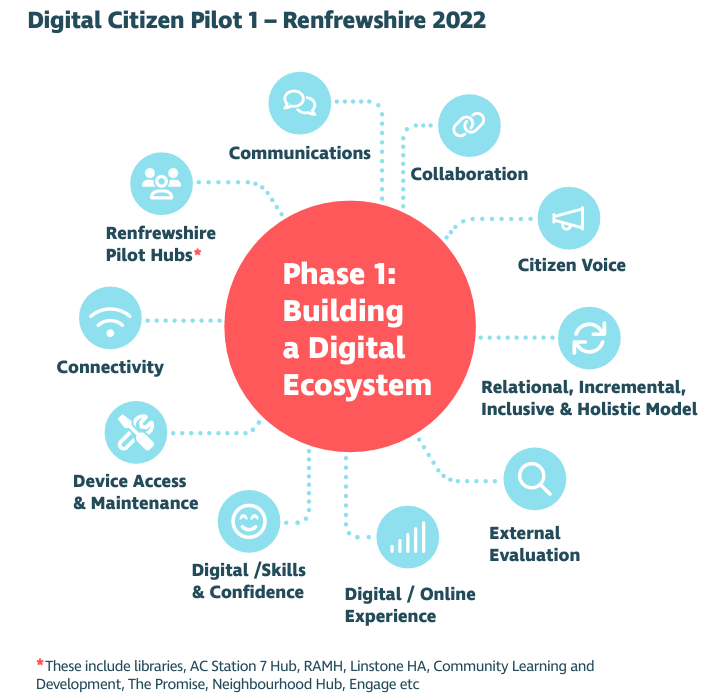Designing your approach
Vision
Work with local stakeholders to create a shared vision of what digital inclusion looks like in your community. This vision should be informed by the needs and assets identified in the discovery phase. Emphasise the importance of involving diverse stakeholders in this process to ensure that solutions are tailored to the specific needs and cultural nuances of the community. For example:
“Everyone in the Garnock Valley has assess to good quality connection and devices which meets their needs and has the skills to use them”.
Your place-based digital inclusion initiative can be part of something bigger. By participating in this work your organisation is making huge strides towards meeting the 'partnership' pledge of Scotland's Digital Inclusion Charter.
Co-create solutions
Collaborate with community members to create solutions that address the identified challenges. This can involve designing new programmes, repurposing existing resources, or forming partnerships with local organisations. A collaborative approach, where diverse stakeholders come together to co-produce solutions, is more robust against funding challenges, leadership changes and shifting organisational agendas that may inhibit progress. Organising and maintaining commitment from multiple stakeholders requires significant coordination. Competing priorities and limited availability can make this challenging.
In this video, Rona from Capital City Partnership shares how they design digital literacy support within a place-based approach:
Project plan
A clear project plan can help keep your initiative on track. This will be particularly important when you're working cross-sector with multiple partners and stakeholders. A shared project plan can help promote ownership of tasks and ensure everyone is working towards the same goals.
Key questions for your project planning:
- What's the problem we're trying to solve?
- What's in scope/not in scope?
- What needs have been identified?
- Who needs to be involved?
- What assets do we already have?
- What additional resource do we need?
- What is our timeline?
- What are our milestones/goals?
- What risks have we identified and how do we manage these risks?
- What does good look like and how will we know we've achieved this? Check out Evaluation Support Scotland for lots of great resources on planning your evaluation.
Define clear, measurable goals for your digital inclusion initiatives. These goals should address the specific barriers identified and leverage the assets available within the community.
Understanding your achievable wins!
- Using the left jigsaw piece group 3 examples from the bridge exercise,
- Using the right jigsaw piece, group the assets from the traffic light exercise,
- In the middle space identify achievable wins.

Work in iterations

Being iterative, agile, flexible and responsive enables a quicker pace of working and supports better outcomes. We recognised early that this work needed to build critical mass in the places we worked in, and in order to do that we needed to work in an action-focused and agile way, as demonstrated in Renfrewshire. This enabled us to avoid ‘talking shops’ within the context of the Citizen Voice meetings. Engagement rates, as a result, were high throughout the process. It also enabled the setting up of ‘co-production groups’, developing a working model within two sessions, and securing the appropriate funds to take it forward. In other areas, where the result of meetings wasn’t action, momentum quickly tapered off.
In developing the pilot idea, we also recognised the importance of identifying a specific place to test the work. Johnstone was chosen as the location of our first pilot mainly due to a mixture of existing assets and identified needs, in addition to the number of partnership opportunities and potential for collaboration going forward. As part of the ‘Develop’ stage, it became clear during our conversations with the Citizen Voice group that Digital Champions needed to be involved in the service design process, and we will be supporting Citizen Voice to form a co-production group to lead on this work in early 2022.
Building organisational capabilities
Place-based digital inclusion is greater than the sum of its parts, but the parts can always benefit from a little help. The individual organisations participating in your place-based initiative may be quite new to digital inclusion, but they can still play a significant role.
How SCVO can support organisational capabilities:
- Start with a digital inclusion health check. Our Digital Inclusion Maturity Check-up. The check-up will take about 10 minutes to complete, and you will see your result straight away. You’ll also get a link via email so you can share it with your team too.
- You can also check digital skills through our Essential Digital Skills Check-up tool or a customised workforce digital skills audit for voluntary sector organisations.
- All SCVO's support for the voluntary sector is free and can be found on our website.
SCVO place-based support
Our FREE 3-session programme on place-based digital inclusion is designed to support partnerships to come together and design solutions that work for your community. We usually run these sessions in-person, but we can also do it online, and they are usually all delivered over 2 months to prompt action.
In the first session, we will conduct a comprehensive assessment to understand the unique digital needs and challenges faced by your community. We will look at the current level of digital engagement, name barriers, and uncover opportunities for growth. By gaining insights into the specific requirements of your community, we can tailor our approach to maximise impact.
In session 2 we use our discovery outputs from session 1 to start defining our solutions. We will focus on creating your vision for place-based digital inclusion, achievable wins and an action plan.
In our final session we review our action plan, governance of the partnership and additional resources required to achieve and sustain our vision for place-based digital inclusion.
For more information about this work, please contact:
Darran Gillan
Digital Inclusion Development Officer
Darran.Gillan@scvo.scot

